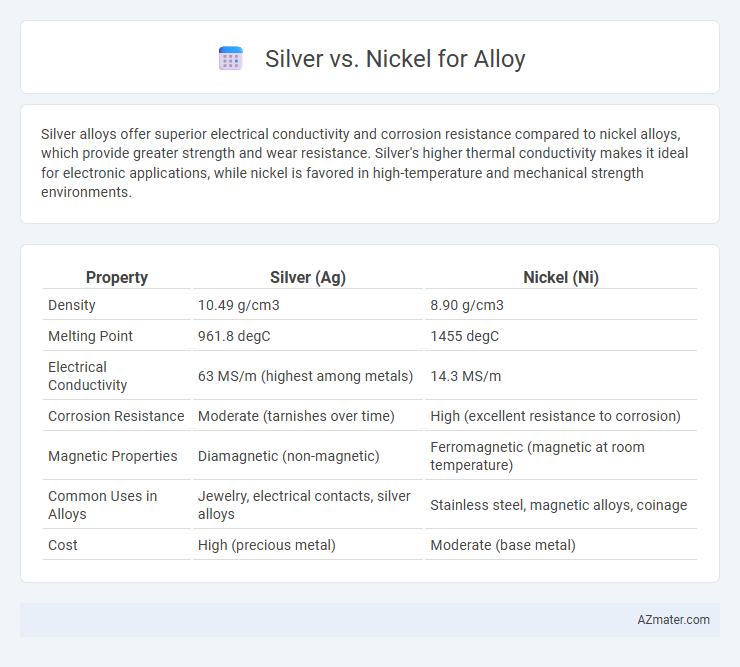Silver alloys offer superior electrical conductivity and corrosion resistance compared to nickel alloys, which provide greater strength and wear resistance. Silver's higher thermal conductivity makes it ideal for electronic applications, while nickel is favored in high-temperature and mechanical strength environments.
Table of Comparison
| Property | Silver (Ag) | Nickel (Ni) |
|---|---|---|
| Density | 10.49 g/cm3 | 8.90 g/cm3 |
| Melting Point | 961.8 degC | 1455 degC |
| Electrical Conductivity | 63 MS/m (highest among metals) | 14.3 MS/m |
| Corrosion Resistance | Moderate (tarnishes over time) | High (excellent resistance to corrosion) |
| Magnetic Properties | Diamagnetic (non-magnetic) | Ferromagnetic (magnetic at room temperature) |
| Common Uses in Alloys | Jewelry, electrical contacts, silver alloys | Stainless steel, magnetic alloys, coinage |
| Cost | High (precious metal) | Moderate (base metal) |
Introduction to Silver and Nickel Alloys
Silver alloys exhibit exceptional electrical conductivity, corrosion resistance, and antimicrobial properties, making them ideal for electronic components, jewelry, and medical devices. Nickel alloys offer superior strength, heat resistance, and oxidation resistance, which are crucial in aerospace, chemical processing, and power generation industries. The choice between silver and nickel alloys depends on the specific application requirements, balancing conductivity, durability, and environmental conditions.
Chemical Properties and Composition
Silver alloys primarily consist of silver combined with copper or other metals, offering excellent electrical conductivity, corrosion resistance, and antimicrobial properties due to silver's stable atomic structure and low reactivity. Nickel alloys contain a higher proportion of nickel, known for its strength, resistance to oxidation, and ability to maintain mechanical properties at high temperatures because of its face-centered cubic crystal structure and strong metallic bonding. Chemical composition differences influence application choices: silver alloys excel in electrical and decorative uses, while nickel alloys are favored for industrial components requiring durability and heat resistance.
Mechanical Strength Comparison
Silver alloys typically exhibit lower mechanical strength compared to nickel alloys, making nickel preferable for applications requiring high durability and wear resistance. Nickel alloys are known for their exceptional tensile strength and hardness, often outperforming silver in structural and industrial uses. While silver offers better electrical and thermal conductivity, nickel's superior mechanical properties make it ideal for heavy-duty alloy components.
Corrosion Resistance: Silver vs Nickel
Nickel exhibits superior corrosion resistance compared to silver, especially in environments with acidic or alkaline exposure, making it a preferred choice in harsh industrial applications. Silver, while resistant to oxidation in normal conditions, tarnishes easily due to sulfur compounds in the air, reducing its durability over time. Alloys with nickel provide enhanced protection against rust and chemical degradation, ensuring longer-lasting performance in corrosive settings.
Electrical and Thermal Conductivity
Silver exhibits superior electrical conductivity, with a conductivity rating of approximately 63 x 10^6 S/m, making it the best conductor among metals. Nickel, with a conductivity around 14.3 x 10^6 S/m, performs significantly lower in electrical conduction but offers better mechanical strength and corrosion resistance compared to silver. In terms of thermal conductivity, silver also outperforms nickel, at about 429 W/m*K versus nickel's 90.9 W/m*K, making silver alloys preferable for applications requiring efficient heat dissipation and high electrical performance.
Applications in Industry
Silver alloys are highly valued in electronics and medical equipment due to their exceptional conductivity and antimicrobial properties, making them ideal for high-performance connectors and surgical instruments. Nickel alloys excel in aerospace, chemical processing, and marine industries because of their outstanding corrosion resistance, high strength, and durability under extreme temperatures. The choice between silver and nickel alloys hinges on specific application needs, balancing electrical conductivity against mechanical resilience and environmental resistance.
Cost and Availability of Silver and Nickel
Nickel is generally more cost-effective and widely available compared to silver, making it a preferred choice for large-scale alloy production. Silver, while offering superior electrical conductivity and corrosion resistance, is significantly more expensive due to its rarity and demand in electronics and jewelry industries. The price volatility of silver and its limited supply often restrict its use in alloys where cost efficiency and abundance are critical factors.
Environmental Impact and Sustainability
Silver alloys generally have a lower environmental impact compared to nickel due to silver's higher recyclability and reduced toxicity during mining and processing. Nickel mining often results in significant ecological disruption, including soil erosion and water contamination, whereas silver extraction tends to produce fewer hazardous byproducts. Sustainable practices in silver alloy production emphasize closed-loop recycling systems, minimizing waste and energy consumption relative to nickel-based alloys.
Health and Safety Considerations
Silver alloys offer superior biocompatibility and lower allergenic risk compared to nickel, which is a common cause of contact dermatitis and allergic reactions. Exposure to nickel alloys can lead to skin sensitization and respiratory issues, making silver a safer alternative for medical implants and jewelry. Regulatory agencies often restrict nickel content in consumer products due to its potential toxicity, highlighting the health benefits of silver in alloy applications.
Choosing the Right Alloy for Your Needs
Silver alloys offer excellent electrical conductivity and corrosion resistance, making them ideal for jewelry and electronic contacts, whereas nickel alloys provide superior strength and oxidation resistance suited for high-temperature and industrial applications. When choosing the right alloy, consider factors such as mechanical performance, environmental exposure, and cost efficiency specific to your project requirements. Understanding the distinct properties of silver and nickel alloys helps optimize durability and functionality in targeted applications.

Infographic: Silver vs Nickel for Alloy
 azmater.com
azmater.com